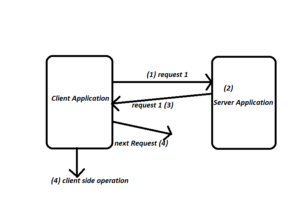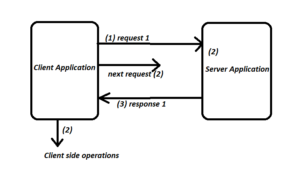What is Microservices Architecture?
Microservices Architecture Software development follows an architectural and organizational approach where small independent services communicate with each other through well-defined APIs.

Overview of Microservices Architecture
Microservices architecture provides a set of rules and guidelines to develop a project as a set of loosely coupled/de-coupled services, and this can be implemented using Spring Boot + Spring Cloud + Netflix and many other tools.
In this project, we will develop each module as a separate microservice using Spring Rest Controllers and the Spring Boot environment.
R&D Server
Once the microservices project is ready, it will be deployed in a cloud environment like AWS/Azure/Google Cloud, etc., with DevOps tools like Jenkins with CI/CD, Docker, Ansible, Kubernetes, or other tools.
After developing each microservice as a separate Spring Rest APP/Project, you must publish it in a common place called an R&D Server like Netflix Eureka Server/Apache Zookeeper, etc.
On the R&D server, a microservice can locate another microservice and utilize it for communication via the same server. A microservice can locate and connect with other microservices only when it is published on an R&D server.
Config Server
The Config Server, such as GitHub or GitLab, can be used to store the common properties with the same values of multiple microservices.
Circuit Breaker
The admin UI/Dashboard must be notified if any exceptions are produced during the execution of a single microservice with the assistance of Circuit Breakers like Netflix Hystrix and Resilience4J.
Load Balancer Client
If any microservice has more demand, then we allow the creation of multiple instances dynamically. In that situation, to pick up the right instance with less Load Factor from other microservices, we use a Load Balancer Client (LBC) like Ribbon, Feign Client, HTTP LoadBalancer, etc.
Integrations
Since we are developing every microservice as a Spring Rest APP in the Spring Boot environment, we can make these microservice applications integrate with many other facilities like MQs(Message Queue), Mail, Caching, Batch Processing, and more.
Database Interaction
Microservices can interact with SQL database software using Spring Data JPA and with NoSQL database software using Spring Data NoSQL modules like Spring Data MongoDB, Spring Data Cassendra, and more.
Spring Boot Admin UI/Dashboard
We monitor and manage all of the microservices in the project using the Spring Boot Admin UI/Dashboard, which was created with the assistance of Spring Boot Actuators and is useful in delivering non-functional features like health metrics on the project.
Distributed Logging & Tracing
Since the project contains multiple microservices interacting with each other, we need to perform logging and tracing activity across the multiple microservices as needed. With the support of Distributed Logging and Tracing tools like Sleuth and Zipkin, Kibana, Splunk, etc., we can effectively manage and monitor the interactions between the microservices. This will help us to identify and troubleshoot any issues that may arise during the communication between the microservices.
Frontend Application
The project microservices can have different types of clients (Frontend Applications) Mobile Apps, Web MVC Apps, third-party apps, UI technologies, and more.
API Gateway
To use all these microservices and tools from the different types of Clients (Frontend Apps), we need one common entry/exit point like API Gateway like Netflix Zuul/ Kong, etc., and proving facilities to apply Filters, Routers, and Security like SSO (Single Sign On).
Sometimes, synchronous communication is not sufficient among the microservices because synchronous communication needs to activate microservices to participate in interaction. To overcome this problem, we choose message-based asynchronous communication using the support of MQs (Message Queue) like Kafka, RabitMQ, ActiveMQ, and JMS.
Synchronous Communication
Synchronous communication means that two parties of communication must be in active mode at a time. The client application should wait for the server application to deliver a result/response to generate a further request to perform client-side operations.

As depicted above, the client is not free to generate the next request or to perform client-side operations until the given request-related response comes back to the client application from the server application.
Note: By default, all communications are synchronous communications
a) browser to web application.
b) Rest API to Rest API using Rest Template, etc.
Asynchronous Communication
Asynchronous communication is when two parties of communication do not need to be in an active state. Here, the client application is free to generate the next request or to perform client-side operations without waiting for a given request-related response. 
Example:
- Browser to web application using Ajax
- Java application to Java using JMS messages, Active MQ, Rest API to Rest application using (Kafka, JMS) messages


Thank you for sharing insights into Microservices Architectural Design using Spring Boot! Your comprehensive guide provides invaluable information on how to effectively implement microservices architecture using Spring Boot, offering developers a clear understanding of the principles, best practices, and tools involved. From breaking down monolithic applications into smaller, independently deployable services to leveraging Spring Boot’s features for building and deploying microservices, your article serves as an essential resource for developers looking to adopt this modern architectural approach. I appreciate the depth of knowledge and clarity with which you’ve presented the concepts, making it easier for developers to grasp and apply them in their projects. Your contribution to the developer community is truly commendable, and I’m grateful for the guidance you’ve provided through this informative post. Keep up the fantastic work!
Sergio, I appreciate you finding my article useful and expressing your gratitude.
Nice blog bhushan, it’s very informative.
It is really amazing and fantastic job done by you on microservices architecture design using Spring Boot is a gem! The clarity with which you explain the intricacies of building scalable and resilient systems with microservices is truly commendable.
Keep up the fantastic work, your expertise shines through every word.
Nice introductory article explaining the components of MSA.
Spring Boot has revolutionized my approach to microservices architecture! Its intuitive design and seamless integration make development a breeze. Highly recommend to all developers exploring microservices
Thanks for sharing such a great information.. It really helpful to me..I always search to read the quality content and finally i found this in you post. keep it up!
Very informative article. Thanks for writing this Bhushan.
Thank you Saichand.
Enlightening Bhushan!! Good Job!!!
Thank You, Ankita
Thank you, Mohit
Thank you, Pratik
Thank you, Palash
Thank you, Yogita
Thank you Rasika.
Light up the concept!! Good Job 👏
Thank you Juhika